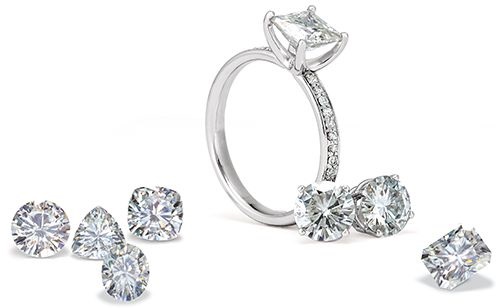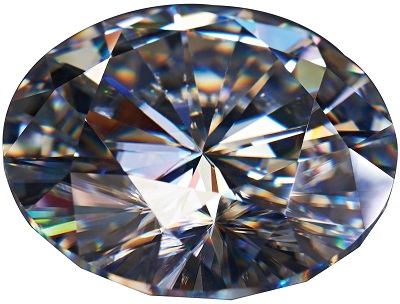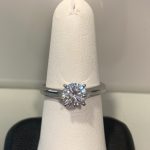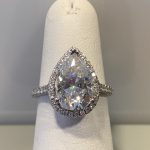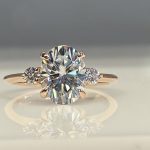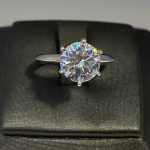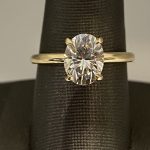Moissanite
Below we have answered some of the frequently asked questions about moissanite.
What is a moissanite?
Moissanite is a rare, naturally occurring mineral also known as silicon carbide, which was first discovered by the Nobel Prize-winning chemist Dr. Henri Moissan at the site of a massive meteorite strike in Arizona. This intriguing new stone was named moissanite in his honor, and Moissan spent the rest of his life attempting to recreate this rare mineral in his laboratory. It wasn’t until the late 90’s that scientists – working in a research laboratory located in Research Triangle Park, North Carolina – developed the innovative thermal growing process that creates silicon carbide crystals. These crystals are fashioned into moissanite gemstones that rival any natural gemstone for fire and brilliance. These man-made gems are more durable than diamond, sapphire, ruby or emerald.
How do you identify a moissanite?
Double Refraction: View moissanite with a magnifying loupe (10x) through its crown or pavilion. Doubling of the back facet junctions can be seen.
Inclusions: Under magnification, you will see needle-like inclusions perpendicular to the table. All moissanite is eye clean.
Dispersion and Refractive Index: When viewed under a high-intensity light, moissanite has greater fire and brilliance than a diamond, a result of its high refractive index and dispersion.
Testers: Moissanite testers used with a thermal diamond tester can easily distinguish moissanite.
What property of moissanite makes it sparkle with such exceptional brilliance?
The most significant optical property affecting a gemstone’s brilliance, or sparkle, is the refractive index or RI. The RI of moissanite ranges from 2.65 to 2.69, meaning it displays more brilliance than diamond (with an RI of 2.42) or any other popular gemstone.
What gives moissanite its fire?
A gemstone’s fire is determined by a gemological property called dispersion. Dispersion refers to the prism effect that occurs when pure white light enters a non-opaque object, breaks into spectral (rainbow) colors, and reflects back to the viewer. Moissanite’s dispersion is 0.104, which exceeds that of any gemstone, including diamond, ruby, sapphire and emerald.
Is moissanite graded on the GIA diamond color grading scale?
Moissanites are graded based off of the GIA diamond color grading scale. There are three grades of moissanite available today: colorless (D-E-F range), near-colorless (G-H-I range) and with faint hues of color (J-K range).
Harold Finkle “Your Jeweler” offers all three grades of moissanite available. The colorless (D-E-F range) is an exclusive series of pure, colorless moissanite. This stunning achievement required the development of highly refined technologies. The colorless moissanite is the ultimate choice for bridal and fine jewelry — one that costs only a fraction of a comparable diamond. The near colorless (G-H-I range) has a noticeably brighter and purer sparkle that delivers breathtaking bursts of vivid color. The near colorless is up to four shades whiter than the original created moissanite gem. The faint hues of color (J-K range) has the faintest hints of green, grey, teal, and yellow that add alluring definition to the facets. It offers you affordable luxury conceived in brilliance, for bridal and fine jewelry.
Does moissanite have inclusions?
Yes. Moissanite can have needle-like inclusions that can be seen under 10x magnification. However, they are not visible to the naked eye and do not affect the clarity of the stone. It’s worth noting that nearly every gem has some sort of inclusion. They are unique characteristics, which occur in the formation of the crystalline structure.
Are fancy cuts available?
Yes. Moissanite is available in various shapes and sizes. The most popular cut continues to be the round brilliant cut, and fancy cuts such as ascher, cushion, oval and square brilliant are available as well.
Why is moissanite sold by millimeter rather than by carat weight?
The carat is the traditional unit of measurement for a diamond’s weight. Moissanite is not measured in carats because it weighs approximately 10 percent less than diamond. For example, a 6.5mm round diamond would weigh 1.00ct, while a 6.5mm round moissanite would weigh 0.88ct. The two stones would be the same size – 6.5mm in diameter.
How should I care for my moissanite jewelry?
You may clean moissanite the same way you would diamond or any other fine gemstone. As with any fine jewelry item, an ultrasonic cleaner can be used. However, it is best to be gentle with your valuable treasures. You can also clean your moissanite jewelry using a commercial (non-acid based) jewelry cleaner or with mild soap and water using a soft toothbrush. Complimentary jewelry check and cleanings are offered by Your Jeweler.
If you have any other questions, please feel free to call or email us at Harold Finkle Your Jeweler.
Phone: (518) 456-6800
Email: justin@yourjeweler.com
